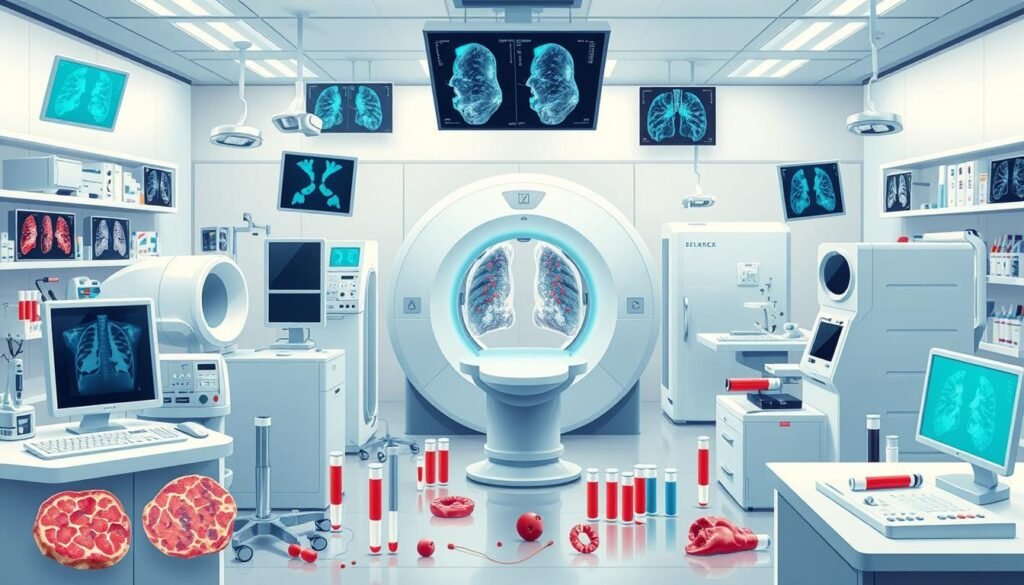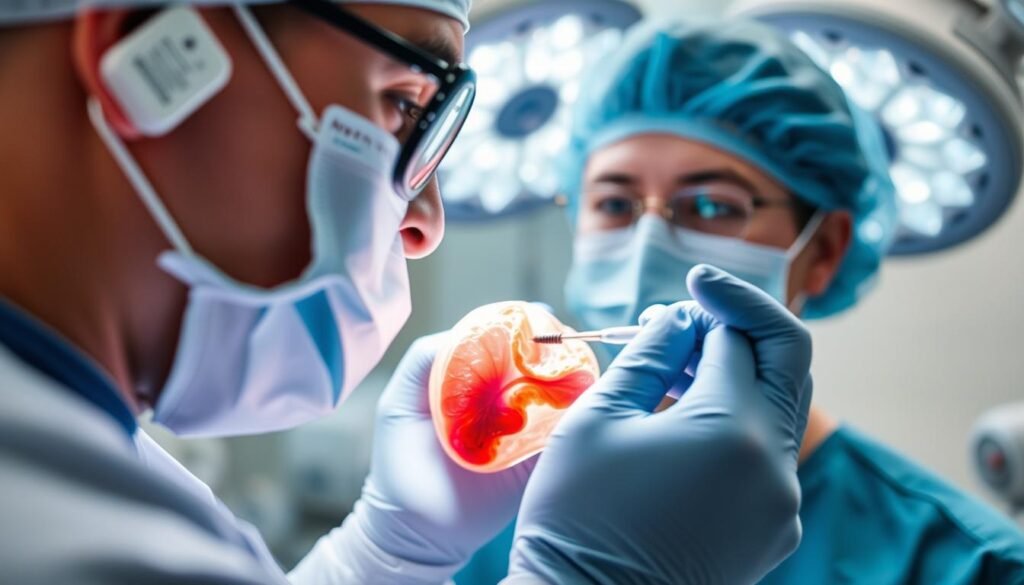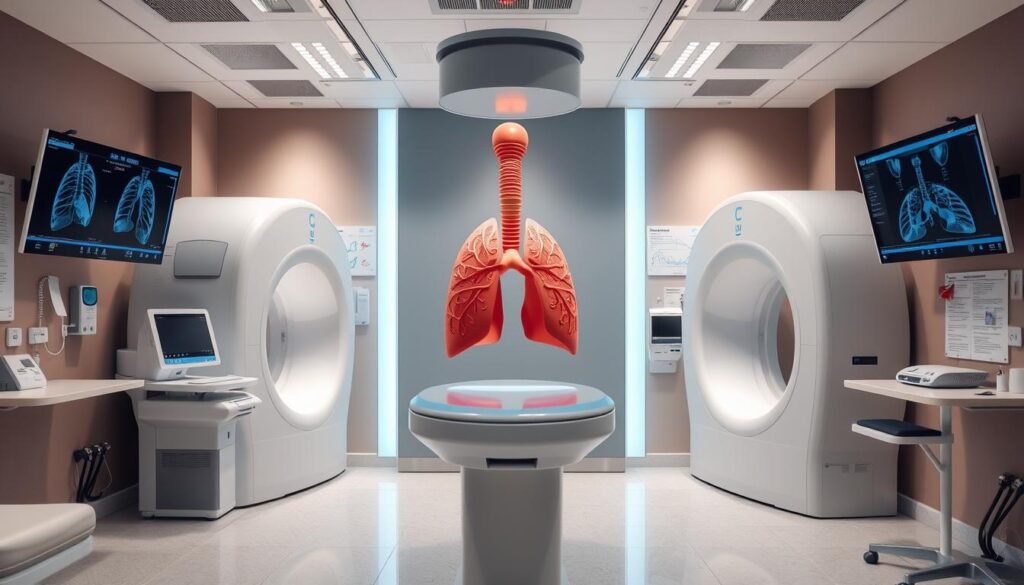Nearly 80% of lung cancer diagnoses begin after seeing a general practitioner. This is often due to symptoms like a lasting cough or shortness of breath. This fact underlines the need to grasp lung cancer diagnosis and follow-up tests. Catching lung cancer early can hugely improve how well treatments work.
Let’s look at the main tests used to diagnose lung cancer. These include imaging exams and biopsy procedures critical in confirming cancer’s presence. We’ll also see why knowing lung cancer’s stage is important. It helps doctors customize treatment plans for each patient.
Key Takeaways
- Lung cancer diagnosis often begins with a GP visit when symptoms arise.
- A chest X-ray is typically the first line of imaging to help identify lung cancer.
- CT scans provide more detailed images to help further evaluate potential lung cancer.
- Biopsy procedures, including needle biopsies and bronchoscopy, are crucial for confirming lung cancer.
- Staging is an important step in planning effective treatment for lung cancer patients.
- Genetic testing can provide insights into targetable mutations, guiding personalized therapies.
Introduction to Lung Cancer Diagnosis
Doctors start diagnosing lung cancer by looking at symptoms and risk factors. They review the patient’s medical history and do a check-up. Symptoms like constant coughing, losing weight without trying, and hard breathing need more tests. Catching the disease early is very important. It helps make the treatment work better and can improve survival.
Diagnostic tests for lung cancer begin with imaging tests and biopsies. A chest X-ray usually comes first to spot anything unusual in the lungs. CT scans, more detailed, are vital for finding tumors early. MRI scans and PET scans may follow. They check if cancer has spread and how much.
Beyond imaging, doctors sometimes need to do biopsies. They take tissue samples from suspicious areas to check for cancer. Procedures like thoracentesis also help. It removes fluid from the lungs, making breathing easier. For a comprehensive guide on diagnosing lung cancer, visit NHS Lung Cancer Diagnosis. Keeping up with how lung cancer is diagnosed is important in the fight against it.
Importance of Early Detection
Finding lung cancer early is key to saving lives. It is the second most common kind of cancer and the top cause of cancer deaths in the U.S. Early detection allows for more treatment options, like surgery or targeted therapies. When found late, treatment gets tougher, involving chemo and care to ease symptoms.
Getting diagnosed early has huge benefits. The American Cancer Society recommends yearly scans for those aged 50 to 80 who smoked a lot. If you smoked for at least 20 years, you should get checked. Early checks, with things like LDCT scans, can spot lung changes early. This can lead to faster treatment that can save lives.
It’s important to know LDCT scans use a bit more radiation than regular chest x-rays. But, they are better at finding cancer early, which can lower death rates. Talk with your doctor about the screening. This way, you know the risks and benefits.
| Screening Method | Age Range | Smoking History | Outcome |
|---|---|---|---|
| Low-Dose CT (LDCT) | 50-80 | 20 pack-year history | Increased survival rates, earlier diagnosis |
| Chest X-ray | All ages | Any | No proven benefit in survival rates |
Knowing early signs and your risk factors is crucial for catching lung cancer early. With the right knowledge and action, you have a better chance at beating it.
Diagnostic Tests for Lung Cancer
Doctors use special tests to find out if someone has lung cancer and how far it has spread. These tests include looking at images of the lungs, taking small pieces of lung tissue to examine, and checking the genes in the cancer. Each test helps decide the best way to treat the cancer.
Imaging Tests Overview
Imaging tests show changes in the lungs. Some tests, like chest X-rays, help find the problem early. Others, like CT scans and PET scans, give more details. A type of CT scan can even find cancer in people who don’t show any signs of the disease. These tools are key in figuring out if someone has lung cancer.
Types of Biopsy Procedures
To confirm lung cancer, a biopsy is needed. This means taking a small piece of lung tissue to look for cancer cells. Doctors can use different methods like a CT-guided biopsy or a bronchoscopy. These help collect tissue from different parts of the lungs. Most times, patients are sedated to make it easier and safe for them.
Genetic Testing and Its Role
Genetic tests help make treatments for lung cancer better suited for each person. They look at the cancer’s DNA to find specific changes that might affect how the cancer is treated. This way, doctors can choose the best treatment for each patient based on their cancer’s unique traits. For more info, check Cleveland Clinic.

Imaging Tests for Lung Cancer
Imaging tests are key in spotting and handling lung cancer. They show us the lungs and the area around them, guiding what to do next. Each test offers different details and views on lung condition.
Chest X-ray: The First Step
A chest X-ray usually starts the search for lung cancer. It can spot unusual spots in the lungs that might be trouble. But, it might not catch small tumors early on. So, more tests may be needed for a clear picture.
Computed Tomography (CT) Scan
CT scans show much more than X-rays. They give cross-sectional images of the lungs. This helps in finding tumors and checking if the cancer has reached nearby areas or lymph nodes. Low-dose CT scans are best for those at big risk with less radiation.
Magnetic Resonance Imaging (MRI) Scan
MRIs are great for looking at soft tissue. They help doctors see if cancer has spread to key spots like the brain or spinal cord. Even though MRIs take more time and are complex, they give detailed pictures for planning treatment.
Positron Emission Tomography (PET) Scan
PET scans offer a peek into the lungs’ metabolic activity. They use a special type of sugar that lights up cancer areas. Often, PET scans are mixed with CT scans. This mix boosts accuracy and offers a full picture of how far the cancer has gone.
Biopsy Procedures: Confirming the Diagnosis
To confirm lung cancer, doctors carry out various biopsy procedures. These are crucial for getting the right tissue samples. The methods help to identify cancer and plan the treatment. Here are some biopsy techniques used for lung cancer.
Needle Biopsy Techniques
Needle biopsy is a common method for lung cancer checks. Doctors numb the area first to ease any discomfort. Then, they use imaging like CT scans to guide a thin needle and take small tissue samples from the lung. This method is quite safe and less risky than surgical options.
Thoracentesis for Fluid Analysis
Thoracentesis is needed when lung cancer causes fluid build-up in the chest. In this process, a needle is used to remove fluid for testing. The fluid can show if cancer cells are present, offering clues about the illness. This simple technique helps in diagnosing and staging the cancer.
Endobronchial Ultrasound (EBUS)
The EBUS procedure is another way to examine the lungs without surgery. It involves an ultrasound on a bronchoscope to see the airways and lymph nodes. EBUS makes it easier to sample tissue from the mediastinum, leading to a more precise lung cancer diagnosis and staging.

Lung Cancer Screening Methods
Lung cancer screening is key to finding the disease early. It’s especially vital for people at high risk. Those 50 and older with a lot of smoking history are mainly who should be screened. Low-dose CT scans are the top way to catch lung cancer early. They are better than old imaging methods.
Who Should Be Screened?
The U.S. Preventive Services Task Force advises yearly lung cancer screenings. They recommend low-dose CT scans for adults 50 to 80 years old. This is for those with a 20 pack-year smoking history. That means smoking one pack a day for 20 years, or two packs a day for 10 years. About 85% of lung cancer deaths are in current or former smokers. Screening them could really help save lives.
Low-Dose CT Scans Explained
Low-dose computed tomography (LDCT) scans are a big step forward. These scans use much less radiation than regular CT scans. Because of this, they’re safer for frequent screening. The National Lung Screening Trial showed that using LDCT can reduce lung cancer deaths by 15 to 20% in high-risk groups.
LDCT is good at finding small nodules that chest X-rays often miss. This improves the chances of finding lung cancer when it’s easier to treat.

| Screening Method | Radiation Exposure | Effectiveness |
|---|---|---|
| Low-Dose CT Scans | 90% less than conventional CT | 15-20% reduction in lung cancer mortality |
| Chest X-Ray | Standard radiation level | Less effective for early detection |
False positives from screening can cause worry and lead to more tests. But, the advantages of early detection with lung cancer screening are much greater than these risks. Health insurance and Medicare often cover the screenings. This makes it easier for more people to get this important screening.
For more about early detection methods, visit this link.
Understanding Sputum Cytology
Sputum cytology is key in diagnosing lung cancer. It examines mucus from the respiratory tract. This method identifies malignant cells. It helps find carcinoma types like squamous cell carcinoma in major airways. Studies show it has an average sensitivity of 65%, ranging from 22% to 98%.
Experts suggest collecting sputum samples in the morning for three days. A study found malignant cells in 11 out of 39 cases. This showcases its use in wider screenings. Another study in Japan detected lung cancer in eight out of 36 cases through sputum cytology.
Sometimes, sputum cytology spots cancer 18 to 36 months before X-rays do. This early detection can greatly increase survival chances. A five-year survival rate of about 80% is possible for these cases. Additional studies show a 75% sensitivity and 98% specificity for lung cancer detection through nuclear image analysis of sputum.
To show the effectiveness of sputum cytology in lung cancer diagnosis, here’s a summary of key findings:
| Feature | Statistic |
|---|---|
| Average Sensitivity | 65% |
| Malignant Cases Detected (Japanese Study) | 8 out of 36 |
| Five-Year Survival Rate | 80% |
| Detection of Malignancy in Confirmed Cases | 60% |
| Sensitivity for Squamous Cell Carcinoma | 76.9% |
| Combined Sensitivity with Bronchoalveolar Lavage Cytology | 86.7% |
Although sputum cytology is effective, it’s not perfect on its own. The chance of a false positive is under 1%. Yet, confirming results with further tests is essential. Sputum cytology can’t always pinpoint cancer’s location or subtype. But, progress in this field looks promising for early detection.
Tests for Staging Lung Cancer
Knowing the tests for staging lung cancer is key. It helps decide the best treatment and outlook for patients. The stage of cancer tells us how much it has spread. It guides the doctors on treatment plans and what to expect in the future.
Importance of Cancer Staging
Cancer staging shows the tumor’s size and spread. Non-small cell lung cancer stages range from I to IV. Small cell lung cancer is labeled as limited or extensive. Knowing all about the cancer helps make a good treatment plan. The stage depends on tumor size, if lymph nodes are affected, and if there’s spread to other parts.
Mediastinoscopy and Mediastinotomy
Tests like mediastinoscopy and mediastinotomy let doctors check the mediastinum and lymph nodes closely. This is crucial for precise staging. It shows if cancer has moved beyond the lungs. To stage lung cancer, doctors use imaging tests and biopsies. They choose the biopsy method based on what’s best for each patient.
Emerging Technologies in Lung Cancer Diagnosis
The way we diagnose lung cancer is changing fast. New tools like liquid biopsies are standout innovations. They analyze tumor DNA from blood, making cancer detection earlier and less invasive.
There’s big progress in imaging techniques too. Digital pathology is improving how we understand images. Artificial intelligence helps doctors read these images better. And machine learning is making CT scans almost 97% accurate in spotting lung cancer.
Studies like the National Lung Screening Trial (NLST) have shown exciting results. They found a 20% drop in deaths when using low-dose computed tomography (LDCT) for screening. Such advancements signal a brighter future for early detection and customized treatments.
A particular model by Wang et al. reached an impressive mark for predicting lung cancer risk. Plus, a natural language processing model analyzing many imaging reports showed great promise. These examples spotlight the power of predictive analytics in fighting lung cancer.
Lung cancer research and diagnosis are advancing quickly, helping many patients. Bringing in new technologies is key to breaking past barriers and bettering patient care.
To learn more about how nanotechnology is making a difference in diagnosis and treatment, check out this comprehensive review.
Conclusion
Finding lung cancer early is key to helping patients live longer. Combining tests like scans, biopsies, and genetic checks gives doctors a full picture of the cancer. This helps decide the best treatment quickly, improving chances of beating the disease.
Not enough people get screened for lung cancer, but it’s really important. Only 16.0% of those who should get checked actually do. Screening, especially yearly low-dose CT scans, can lower death rates by up to 20%. By spotting cancer early, we could save many lives and give people more years to live.
It’s crucial for everyone to know their risk and get screened when needed. Lung cancer is still a major health issue, but early detection is making a big difference. Thanks to better screening, more people have the hope of surviving lung cancer and living healthier lives.